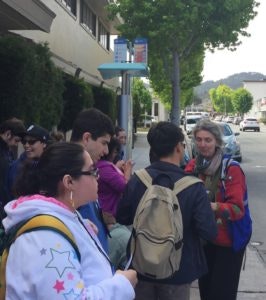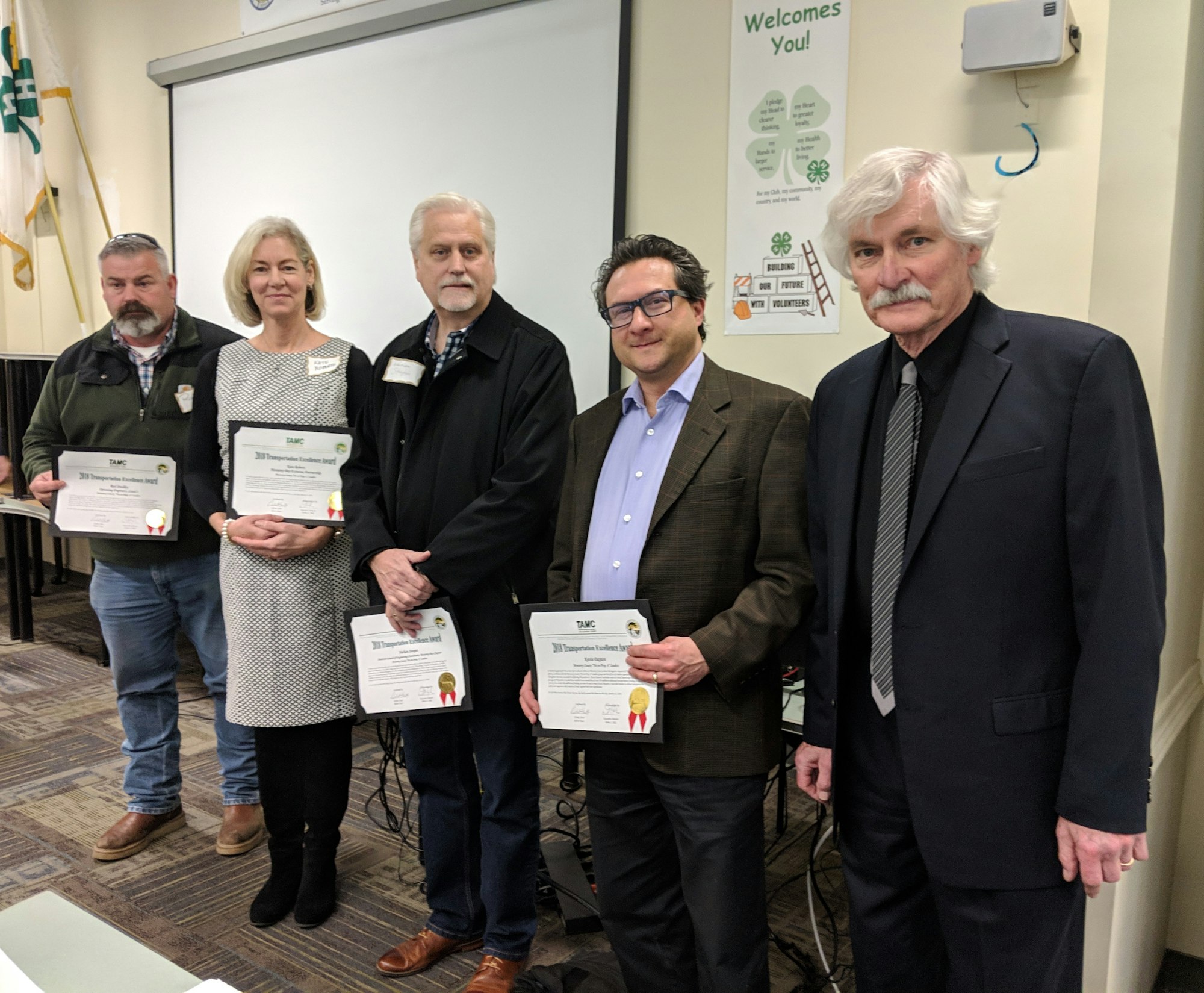2018 Excellence Awards Honorees
The Honorees of 2018 Transportation Excellence Awards are:
Special Individual Award Recognition:
State Senator Anthony Cannella
During his eight years in the California State Senate, Senator Cannella was a leader on transportation issues. As a Civil Engineer and a former member of the Stanislaus Council of Governments, he had a special interest in transportation. He served on the Senate Transportation Commission and carried legislation for TAMC to extend the ability for public-private financing of transportation issues.
But Senator Cannella’s most significant contribution to transportation was his landmark vote in favor of Senate Bill 1 (2017). By leving new vehicle license fees, and not only raising but indexing the gas tax for inflation, SB 1 assured that transportation would finally have a stable funding source over the long-term. Senator Cannella was the only Republican in the Assembly or State to vote in favor of this legislation, and in doing so, he suffered extensive criticism from his party and many of his constituents. In November of 2018, when asked to repeal Senate Bill 1 through Proposition 6, the vast majority of California voters validated Senator Cannella’s support by rejecting the proposition.

Individual Award:
Jennifer Cline
Jennifer Cline is one of the volunteers for Monterey-Salinas Transit. Under the MST Navigator Program, she has been volunteering for the last five (5) years. She regularly rides the MST bus system and provides assistance to other riders as needed. During her volunteer work hours, she answers questions about MST bus lines, provides directions, or informs those who appear to be struggling to board or get off the bus. Jennifer is also trained in MST’s travel training program to help individuals with limited experience and encourage them to ride the bus safely and independently. She has also worked alongside MST staff at community centers and outreach events to promote riding the MST bus system and to provide information on MSTs Mobility programs.

Individuals
- Heather Lanier/Carissa Chapellet - Big Sur Bypass Trail Project
- John Viarengo - Salinas Traffic and Transportation Commission
Programs
- Reduced Pricing Bus Passes - Monterey-Salinas Transit
- Bike and Pedestrian Safety Public Education Program - City of Monterey
Projects
- Holman Highway 68 Roundabout Project - City of Monterey, Caltrans
- Pfeiffer Canyon Bridge - Caltrans
- Elkhorn Road Emergency Storm Damage Repair - County of Monterey
Group Award:
Monterey County “No on Prop. 6” Leaders
Each of the members of the Monterey County “No on Prop. 6” Leaders group and the organizations they represent reached beyond their own organization and took an active role in Monterey County to educate others about the negative impacts of Proposition 6. Proposition 6 would have resulted in an annual loss to our region over $30 million dollars per year-money that can now be used to match local Measure X and other monies to deliver transportation safety and congestion relief projects of local, regional and state significance.
Due to their efforts, and the efforts of similar organizations and volunteers throughout the state, these individuals and their organizations succeeded in defeating Proposition 6. Their activities were of critical importance to the future of transportation funding, particularly because, as a public entity, TAMC in not able to advocate for or against a ballot measure.
The members of the Monterey County “No on Prop. 6” Leaders being honored are:
- Kevin Dayton, Salinas Taxpayers Association
- Barbara Meister, Monterey Bay Aquarium/ Monterey County Hospitality Association
- Kate Roberts, Monterey Bay Economic Partnership
- Deanna Sessums, League of California Cities
- Rod Smalley, Operating Engineers, Local 3
- Nathan Stoopes, American Council of Engineering Consultants, Monterey Bay Chapter

Event Award:
Ciclovîa Gonzales
Ciclovîa Gonzales is a free community event that focuses on creating healthy communities through the building of partnerships among city residents, school districts, nonprofit agencies and the broader community. This year, the Monterey County Health Department worked together with the City of Gonzales and Building Healthy Communities to put together the first Ciclovîa event in south Monterey County.
As a family event that closes the streets to motor vehicle traffic, Ciclovîa Gonzales offers the community a space to enjoy biking, walking, and free activities in a safe environment. This year, over 100 volunteers of all ages donated their time to plan and implement this event. In addition, over 35 agencies from all over Monterey county were present at the event offering their services and information to participants. Over 900 community members from throughout the County attended the very first Ciclovîa event in South County.
Program Award:
“Ride the 40s on Us”
Like many other public transit agencies across the nation, Monterey-Salinas Transit is always looking for creative and innovative ways to increase ridership. When they were informed about their formula funding amount under the newly created California Climate Investment Grants under the Cap and Trade program, they immediately thought about investing in Salinas. The program requires that the funding be spent in areas which benefit local disadvantaged communities, the largest of which is in Salinas along the East Alisal corridor.
In September 27, MST introduced “Ride the 40s on Us” to their passengers and residents in September 2017 and the campaign will continue through August 2019. “The 40s” are the Salinas based transit lines which operate on weekends and holidays. These lines were the target of the promotion. Anyone seeking a ride on one of the 40s lines boards for free. Additionally, complementary ADA paratransit is free on weekends and holidays in Salinas. Through a California Climate Investment Grant, residents of this disadvantaged area now have access to public transportation on the weekends for shopping, work, and healthcare. Although the target audience was initially defined by MST’s funding source, the residents of the entire area of Salinas benefit from this promotional effort.
With a limited budget and a lot of public outreach in the community, MST increased ridership on the weekends and holidays on Salinas lines by 80%. The ridership increase was so significant that it increased MST’s overall systemwide ridership by 2.3%, bucking the national downward trend in bus ridership.

Project awards:
Castroville Bike/Ped Path & RR Crossing
The Castroville Bicycle Pedestrian Path and Railroad Crossing project constructed a 0.74-mile path from McDougall Street to Castroville Boulevard, that included constructing a 1,170-foot bridge over the Union Pacific Railroad tracks. This $10.6 million project was designed to create safe and healthy routes for students to walk or ride bikes to and from school. Prior to the construction of the project, students who walk or bicycle from Castroville would often go up and over an active railroad track, along a farm field, and then cross over a busy section of Castroville Boulevard to reach the existing bicycle/pedestrian path along Castroville Boulevard to get to their school.
The bridge now provides students a much safer route to school and connect downtown Castroville to Elkhorn Elementary School and North Monterey County High School. It also links various portions of the existing multi-modal transportation infrastructure improving access for all bicyclists and pedestrians from the Monterey Peninsula, Salinas to Watsonville, to Santa Cruz County.

Fremont/El Sausal Safe Routes to School
In collaboration with the Monterey County Health Department and TAMC, the Fremont/El Sausal Safe to School Project is located next to Fremont Elementary School and El Sausal Middle School. The schools front East Market Street and are less than one block apart with a combined student population of 1,803 students from kindergarten to eighth grade. The schools are low-income area, resulting in higher pedestrian activity, with most students either walking, biking or skating to school. The remaining students commute to school using one of the two available school bus routes, public transit, or by car.
The Safe Routes to School project implemented a road diet that reduced the number of vehicle travel lanes from 4-lanes to 2-lanes, created buffered bicycle lanes and improved the pedestrian facilities on East Market Street between Sanborn Road to Williams Road. The reduction of vehicle travel lanes slows traffic and the addition of a center left turning lane reduced conflict points between turning vehicles and other road users.
Other enhancements include high visibility crosswalks, bulb-outs, the first installation of a separated bikeway in the City of Salinas, bike boxes, and the installation of two coordinated traffic signals which allows vehicles to drive along the corridor with minimal stopping times, reducing traffic delays during peak travel times.
Mud Creek Landslide
Highway 1 through Big Sur is a symbol of Caltrans ability to design and construct infrastructure that strikes a balance with nature. This route includes a 70-mile-long ribbon of pavement which straddles a rugged coastline and is world-renowned for transporting people to a most beautiful, tranquil and serene place. Part of this natural beauty includes the dynamic landscapes, making every drive and bicycle ride a truly unique experience. Since the highway was completed in the 1930s, countless landslides and unceasing erosion have changed how the roadway traverses the coast.
In 2017, some of the most catastrophic storms in recent history severely damaged the highway and closed it for more than a year. There were numerous emergency highway closures including Paul’s Slide and the Pfeiffer Canyon Bridge, which cut off critical access for those who lived, and worked on, or traveled along the highway. In January, sections of the embankment at Mud Creek failed. Rock, mud and debris continually slid down the mountainside. On May 20, 2017 50 acres of land and more than five million cubic yards of earth broke free from the mountainside. With a thunderous roar-likened to an earthquake-a new 15-acre peninsula was crated and 1,000 feet of Highway 1 was buried beneath 160 feet of earth materials.
After months of construction under challenging circumstances and trying times, the highway was reopened on July 18, 2018. Local residents can now use the highway to travel again and the need for a two-hour detour to travel south of Gorda has ended. Central coast business and economic interests are being met with the facilitation movement of goods, services and people. International visitors to the Big Sur area also appreciate that the iconic highway is open again along the entire Big Sur coast.
West Broadway Urban Village Infrastructure Improvements Project
The West Broadway Urban Village Infrastructure Improvements Project was designed to increase bicycle and pedestrian safety and to promote multi-modal forms of transportation while revitalizing downtown Seaside, enhancing the accessibility of patrons and creating a visually engaging environment around the commercial hub of the city.
The project improvements in June 2018 include a corridor “road diet” that reduced the width of the roadway from a four-lane roadway to two vehicle travel -lanes, bike lanes, pedestrian sidewalks, and streetscape improvements. This project is a good example of implementing “Complete Street” road features to benefit a wide range of people and interests. This investment in the publc facilities will serve as a catalyst to draw private investment into the West Broadway Urban Village area, which will promote economic growth and the creation of an urban core/downtown in Seaside.
